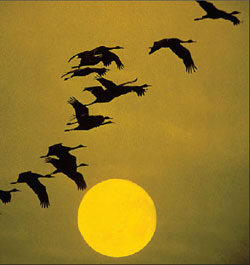Birds
 |
| Storks during night migration. |
Perhaps it was ordained that birds, having mastered flight, would use this power to make the long seasonal migrations that have captured human wonder and curiosity. For the advantages of migration are many. Moving between southern wintering regions and northern summer breeding regions with long summer days and an abundance of insects provides parents with ample food for rearing their young. Predators of birds are not so abundant in the far North, and the brief once-a-year appearance of vulnerable young birds does not encourage the buildup of predator populations. Migration also vastly increases the amount of space available for breeding and reduces aggressive territorial behavior. Finally, migration favors homeostasis—the balancing of physiological processes that maintains internal stability—by allowing birds to avoid climatic extremes, especially circumstances where food is not available in the winter and the short days provide little time to forage for energy needed to sustain a bird for 24 hours.
Still, the wonder of the migratory pageant remains, and there is much yet to learn about its mechanisms. What times migration, and what determines that each bird shall store sufficient fuel for the journey? How did the sometimes difficult migratory routes originate, and what cues do birds use in navigation? And what was the origin of this instinctive force to follow the retreat of winter northward? For it is instinct that drives the migratory waves in spring and fall, instinctive blind obedience that carries most birds successfully to their northern nests, while countless others fail and die, winnowed by the ever-challenging environment.
Of the vertebrates, birds of the class Aves (ay'veez) (L. pl. of avis, bird) are the most noticeable, the most melodious, and many think the most beautiful. With more than 9000 species distributed over nearly the entire earth, birds far outnumber any other vertebrate group except the fishes. Birds are found in forests and deserts, in mountains and prairies, and on all oceans. Four species are known to have visited the North Pole, and one, a skua, was seen at the South Pole. Some birds live in total blackness in caves, finding their way about by echolocation, and others dive to depths greater than 45 m to prey on aquatic life. The “bee” hummingbird of Cuba, weighing in at only 1.8 g, is one of the smallest vertebrate endotherms.
The single unique feature that distinguishes birds from other animals is their feathers. If an animal has feathers, it is a bird; if it lacks feathers, it is not a bird. No other vertebrate group bears such an easily recognizable and foolproof identification tag.
There is great uniformity of structure among birds. Despite approximately 150 million years of evolution, during which they proliferated and adapted to specialized ways of life, we have little difficulty recognizing a living bird as a bird. In addition to feathers, all birds have forelimbs modified into wings (although they may not be used for flight); all have hindlimbs adapted for walking, swimming, or perching; all have horny beaks; and all lay eggs. The reason for this great structural and functional uniformity is that birds evolved into flying machines. This fact greatly restricts diversity, so much more evident in other vertebrate classes. For example, birds do not begin to approach the diversity seen in their endothermic evolutionary peers, the mammals, a group that includes forms as dissimilar as whale, porcupine, bat, and giraffe.
Birds share with mammals the greatest development of organ systems in the animal kingdom. But a bird’s entire anatomy is designed around flight. An airborne life for a large vertebrate is a highly demanding evolutionary challenge. A bird must, of course, have wings for support and propulsion. Bones must be light yet serve as a rigid airframe. The respiratory system must be highly efficient to meet the intense metabolic demands of flight and serve also as a thermoregulatory device to maintain a constant body temperature. A bird must have a rapid and efficient digestive system to process an energy-rich diet; it must have a high metabolic rate; and it must have a high-pressure circulatory system. Above all, birds must have a finely tuned nervous system and acute senses, especially superb vision, to handle the complex problems of headfirst, high-velocity flight.
Position in the Animal Kingdom
Birds are a lineage of endothermic, diapsid amniotes that evolved flight in the Jurassic period of the Mesozoic. Phylogenetically, they are most closely related to certain theropod dinosaurs, a group of bipedal carnivores with birdlike skeletal characteristics. Their closest living relatives are the crocodilians. The morphological characteristics and great uniformity of structure of birds relate almost entirely to the strict demands of flight, and the mobility that flight provides is responsible for many of the distinctive aspects of their behavior and ecology.
Biological Contributions
- Feathers are unique to the bird lineage and distinguish birds from all other animals. The evolution of feathers was the single most important event leading to the capacity for flight in birds.
- In addition to feathers, several other essential adaptations contribute to the two prime requirements for flight: increase in power and decrease in weight. These adaptations include forelimbs modified as strong wings, hollow bones, horny bill (rather than heavy jaws and teeth), endothermy, high metabolic rate (six to ten times as high as reptiles of similar weight and body temperature), large hearts and high-pressure circulation, highly efficient respiratory system, keen vision, and excellent neuromuscular coordination.
- Birds occupy almost every available habitat on the earth’s surface and, within the constraints imposed by the requirements for flight, have radiated modestly in body form, especially in bill adaptations.
- The unparalleled mobility of birds has enabled many to benefit from the advantages of making seasonal and long-distance migrations. Migration enables birds to secure seasonal habitats most beneficial for breeding, finding food, avoiding predators, and reducing interspecific competition.




